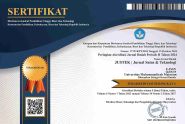Peramalan Jumlah Penumpang di Bandara Internasional Juanda Menggunakan Metode ARIMA, Regresi Time Series, TBATS
Abstract
Abstract: One of the busiest airports in Indonesia managed by PT. Angkasa Pura I is Juanda International Airport. Besides, Juanda International Airport is also one of the gateways for the Indonesian state to other countries. The number of passengers at the departure terminal at Juanda International Airport from 2012 to 2013, both domestic and international routes, has increased by about 6.74%. Meanwhile, the arrival terminal experienced an increase of about 8.31%. From 2013 to 2014 the departure route decreased by 2.51%. Meanwhile, the arrival route decreased by 1.99%. In 2014 to 2015 the departure route decreased by 11.31%. Meanwhile, the arrival route decreased by 0.78%. There is an increase and decrease in the number of passengers at Juanda International Airport, it is necessary to research forecasting the number of passengers at Juanda International Airport, both from domestic routes and international routes. The purpose of this study is to balance number of passengers and number of flights in the future with the availability of the number of aircraft and airport capacity. The data used is data on the number of passengers each month at Juanda International Airport. Where the data was obtained from PT. Angkasa Pura I (Persero). The criteria for selecting the best model based on the RMSE value shows that the best model selected by the ARIMA model has 14 routes, while the selected Time Series Regression model has 9 routes and the selected TBATS model has 7 routes.
Abstrak: Salah satu bandara tersibuk di Indonesia yang diolah PT. Angkasa Pura I adalah Bandara Internasional Juanda. Selain itu, Bandara Internasional Juanda juga merupakan salah satu pintu gerbang negara Indonesia menuju negara-negara lain. Jumlah penumpang di terminal keberangkatan Bandara Internasional Juanda dari tahun 2012 hingga tahun 2013 baik rute domestik maupun internasional mengalami peningkatan sekitar 6,74%. Sedangkan di terminal kedatangan mengalami kenaikan sekitar 8,31%. Pada tahun 2013 hingga tahun 2014 pada rute keberangkatan mengalami penurunan sebesar 2,51%. Sedangkan pada rute kedatangan mengalami penurunan sebesar 1,99%.Pada tahun 2014 hingga tahun 2015 pada rute keberangkatan mengalami penurunan sebesar 11,31%. Sedangkan pada rute kedatangan mengalami penurunan sebesar 0,78%. Adanya kenaikan dan penurunan jumlah penumpang di Bandara Internasional Juanda, maka perlu diadakan penelitian mengenai peramalan jumlah penumpang di Bandara Internasional Juanda, baik dari rute domestik maupun rute internasional. Tujuan dari penelitian ini adalah untuk menyeimbangkan jumlah penumpang dan jumlah penerbangan pada masa mendatang dengan ketersediaan jumlah pesawat dan kapasitas bandar udara.Data yang digunakan adalah data jumlah penumpang tiap bulan di Bandara Internasional Juanda. Dimana data tersebut diperoleh dari PT. Angkasa Pura I (Persero). Kriteria pemilihan model terbaik berdasarkan nilai RMSE menunjukkan bahwa Model terbaik yang terpilih model ARIMA terdapat 14 rute sedangkan yang terpilih model Regresi Time Series terdapat 9 rute dan yang terpilih model TBATS terdapat 7 rute.
Keywords
Full Text:
Download (PDF)References
Aczel, A. D., & Sounderpandian, J. (2008). Complete Business Statistics. United States of America: The McGraw-Hill Companies.
Airports Council Internasional. (2014). Airport Service Quality Awards 2014. Retrieved from http://www.aci.aero/Airport-Service-Quality/ASQ-Awards/Past-Winners/2014.
Alin, O., Mihai, Țichindelean, Marieta, M. D., & Cosmin, T. (2019). Forecasting Passenger Traffic for a Regional Airport. Studies in Business and Economics, 14(2), 105–114. Retrieved from https://content.sciendo.com/configurable/contentpage/journals$002fsbe$002f14$002f2$002farticle-p105.xml
Bowerman, B. L., & O’Connell, R. T. (1993). Forecasting and Time Series (Third Edit). California: Duxbury Press.
Cryer, J. D., & Chan, K. (2008). Time Series Analysis: With Application in R. New York: Springer Science+Business Media.
Daniel, W. W. (2000). Daniel, W. W (D. Press., Ed.). Boston.
Kusumawati, F. A. (2015). Pemodelan Beban Listrik Jawa-Bali dengan Menggunakan Pendekatan Flexible Seasonality Forecasting. Institut Teknologi Sepuluh Nopember.
Lee, M. H., Suhartono, & Hamzah, N. A. (2010). Calendar Variation Model Based on ARIMAX for Forecasting Sales Data with Ramadhan Effect. Regional Conference on Statistical Science. Retrieved from https://www.semanticscholar.org/paper/Calendar-variation-model-based-on-ARIMAX-for-sales-Lee-Hamzah/bd60d8a7e673356b4725b4d6f552a3f3a44bc073
Livera, A. M., Hyndman, R. J., & Snyder, R. D. (2011). Forecasting Time Series with Complex Seasonal Patterns Using Exponential Smoothing. Journal of the American Statistical Association, 106(496). doi: https://doi.org/10.1198/jasa.2011.tm09771
Makridakis, S., & Hibon, M. (2000). The M-3 Competition: Result, Conclusions and Implications. International Journal of Forecasting, 16(4), 451–576. doi: https://doi.org/10.1016/S0169-2070(00)00057-1
Suryani, E., Chou, S., & Chen, C. (2010). Air Passenger Demand Forecasting and Passenger Terminal Capacity Expansion: A System Dynamic Framework. Expert System with Applications, 37, 2324–2339.
The Guide to Sleeping in Airports. (2016). Best Airports in Asia 2015. Retrieved from http://www.sleepinginairports.net/2015/best-airports-asia.htm.
Tsui, W. H. K., Balli, H. O., Gilbey, A., & Gow, H. (2014). Forecasting of Hong Kong Airport’s Passenger Throughput. Tourism Management, 42(3), 62–76.
Wei, W. S. (2006). Time Series Analysis Univariate and Multivariate Methods (Second Edi). New York: Pearson Addison Wesley.
Wulandari, N., Setiawan, S., & Ahmad, I. S. (2016). Peramalan Inflasi Kota Surabaya dengan Pendekatan ARIMA, Variasi Kalender dan Intervensi. Jurnal Sains and Seni ITS., 5(1), 90–95. doi: 10.12962/j23373520.v5i1.14693.
Xie, G., Wang, S., & Lai, K. K. (2014). Short-term Forecasting of Air Passenger by Using Hybrid Seasonal Decomposition and Least Squares Support Vector Regression Approaches. Journal of Air Transport Management, 37(2), 20–26.
DOI: https://doi.org/10.31764/justek.v2i1.3720
Refbacks
- There are currently no refbacks.
JUSTEK : Jurnal Sains dan Teknologi sudah terindeks
EDITORIAL OFFICE:












.JPG)

